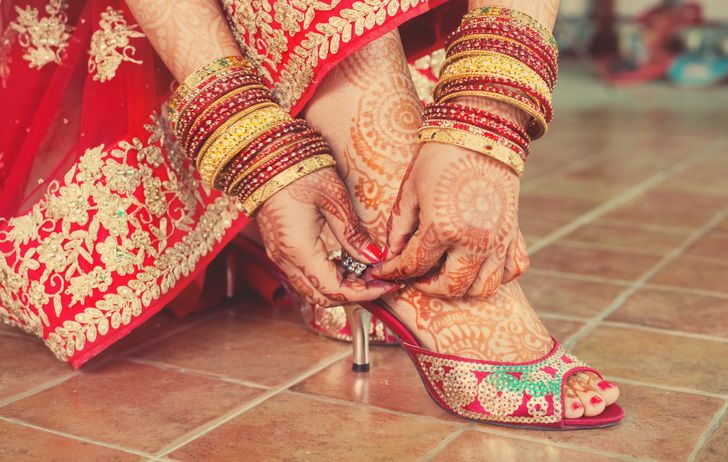1st one is pretty common is few other countries near India
11 Extraordinary Wedding Traditions in India That Are Hard to Believe at First
Indian weddings are not only events of bright celebration, but they also follow strict adherence to traditions and rituals. For example, the date of the wedding is determined by the horoscopes of the bride and groom, not their preferences. There are also certain rules that dictate how the bride should look on this day, like wearing a red dress instead of a white one, donning red powder on the forehead, and sporting intricate henna designs on the feet and hands.
Bright Side has collected some of the most peculiar traditions that are featured in Indian weddings.
1. Women wear nose rings on their wedding day.
On their wedding day, women wear naths, or nose rings, as a symbol of their marriage. It is typically worn on either side of the nostrils and is attached to the ear with a gold chain.
2. Astrology determines the date of a wedding.
Astrology plays quite an important role in Hindu culture. However, it’s not the kind of astrology we study in the Western world, but rather, the Vedic one that speaks more to your karma and dharma. Hindu people believe that if a wedding date is calculated on the basis of a future bride and groom’s horoscopes, it will be long and happy.
3. Brides and grooms should exchange garlands.
One of the important rituals performed at Indian weddings is the exchange of garlands. In ancient times, this exchange was considered the acceptance of a marriage proposal. The bride and groom give each other garlands made of bright, sweet-smelling, blooming flowers. Nowadays, this symbolizes love and respect between newlyweds.
4. A girl can “marry” a tree or a pot.
In India, women have the option of not only marrying a human being, but also a tree or even a pot. This unusual practice has a cultural explanation.
If a woman is born in a particular period — when the chart bears the planet Mars (Mangala), she becomes known as a “Manglik.” There’s a belief amongst Hindu people that this predicament could mean future lousy luck for the future relationship or household. That’s why Manglik women can choose to “marry” a tree stump or pot before their real marriage to ward off the “curse.” After the ritual, the selected object is later destroyed together with its bad luck.
5. The groom’s feet are washed with milk and honey.
6. Red powder is applied to the bride’s hair.
7. A groom can be greeted by flying tomatoes.
8. Henna is applied to the bride’s hands and feet.
Mehendi is probably the most recognizable Indian wedding tradition. Prior to the wedding, a future bride adorns her feet and hands with intricate henna designs. Mehendi ritual happens when the bride and her family gather together. It is believed that henna promotes fertility and wards off evil spirits for the couple.
9. A bride cannot wear a white dress.
Unlike in other countries, Indian brides cannot wear white dresses at their wedding since the color is usually worn for mourning, according to Hindu culture. Instead, women wear bright saris of vibrant colors, preferring red most of the time since it has an array of positive connotations in Indian culture. There are some exceptions, especially with regards to the religion of the married couples; Christian Indian weddings may have the bride, and even the groom, in white.
10. The mother of the bride pulls the nose of the groom.
In Gujarati weddings, there is a quite funny tradition: the mother of the bride pulls the nose of the groom in a friendly and playful manner. By doing this the mother-in-law reminds a new family member that he has to remain humble as he is asking for her daughter’s hand. Meanwhile, a groom has to escape the pulling.
11. A bride takes rice to throw over her head.
At the end of the wedding, a bride should do the last ritual, Vidaai, to say “goodbye” to her parents. During Vidaai, the bride has to throw a bunch of rice over her head and her mother that is standing behind has to catch it. It’s also a symbolic way to thank parents for everything they did for their daughter.
What do you think about wedding traditions in India? Got some cool photos or stories about Indian weddings? Share them with us in the comments below!
Comments
These aren't unusual for India though... We have been doing it since years even before foreigners learn about culture and things... It's the root of our country
And calling it unusual is a little disrespectful in my point of view
Related Reads
10 Awkward Celebrity Moments We Won’t Be Able to Forget

20 Photos of Perfectly Organized Objects That’ll Satisfy Your Inner Perfectionist

20 Random Acts of Kindness That Would Lift Anybody Up

11 Little-Known Body Facts We Wish We Had Known Before

An Illustrator Draws Moments From Her Life That Can Hit Home With Every Girl

20+ Easy and Effective Hacks to Solve Everyday Problems

10 Celebrity Dresses That Took Too Long to Be Designed

I Refuse to Give Up My Inheritance Just Because I’m Childfree

9 Short Stories About True Love

People Shared 15 Awkward Moments That Made Their Stomach Drop

10 Parents Who Take Boundaries and Smash Them Into Dust

10 Married People Who Had Affairs Reveal What Happened Next













